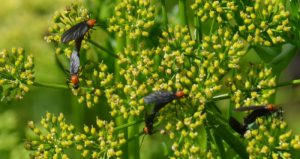By Les Harrison
Lovebugs Not Leaving Its Mark
The pace of life and the unending supply of distractions in 2018 keep most resident’s thoughts occupied with too many diversions. The student’s recent return to school, the elections, the football season and the list goes on and on so one hardly has time to notice an overlooked absence.
The Lovebug (Plecia nearctica) population is not leaving its mark, especially on vehicles, this summer. The frequently reviled conjoined flying insect pairs have been absent in the panhandle recently, but no one has taken credit for the removal.
Contrary to the urban myth, a group of carwash owners from a north central Florida educational institution did not release this irritating insect for nefarious intent.
Lovebugs originated in Central America, but migrated north. By 1949 they had reached Escambia County and today are found in every Florida County.
Lovebugs Etch Vehicle’s Paint
Embellishing the finish of automobile and trucks is this insect’s seeming specialty. They have a justifiable reputation for etching vehicle paint at the point of impact, with a combination of internal chemical compounds.
Their body fluids are slightly acidic and capable of slowly damaging auto paint. Bacterial action on the Lovebug’s remains intensifies the acidity if they remain on the vehicle for several days.
Unfortunately, these creatures have an ill-fated attraction to diesel and gasoline exhaust fumes. Hot engines and vehicle vibrations may also contribute to the premature demise of many unlucky singles and pairs.
Post-appearance chemical control of Lovebugs is pointless. Adult males live an average of two to three days and females may live for a week, if they are fortunate enough to avoid roadways.
The spring months April and May are the largest population emergence of Lovebugs, but this species has been collected in Florida every month of the year except November.

Lovebug’s Life Cycle
The females lay approximately 350 gray, irregularly-shaped eggs in or on the soil surface under partially decayed vegetable matter which is used for food and shelter. Slate-gray larvae are often found in groups where moisture under the decaying vegetation is constantly present, but not excessive.
One of the positive byproducts of the excessively heavy rains and standing waters recently experienced in Wakulla County is many of the larvae will drown. The weather cycle proves to be the greatest control of this species.
Unfortunately, standing water does encourage other problems in addition to an exploding mosquito population. The infamous Yellow Fly, a Horse Fly relative is a tenacious pest with a vicious and painful bite uses the standing water to reproduce in mass.
As with many other biting or stinging insects, it is the female Yellow Fly which bites. She uses knife like mandibles to access the blood of her victims, and is not particular about the source.
The Wet Weather Hatch
The wet weather hatch is currently underway which creates a sudden population outburst, but Yellow Flies have been active all summer. They are active during the daylight hours in shade or full sun.
Females deposit egg masses on plants, rocks, sticks or other similar objects usually over water or other favorable larval habitat. Eggs are deposited throughout the life cycle of the female.
After five to 12 days, the eggs hatch and the young larvae drop into the water or mud where they feed on organic debris or prey on other small aquatic organisms. The yellow flies emerge from the larvae stage ready to begin feeding on livestock, pets and people.
There will always be some sort of flying insect pest no matter the summer’s weather conditions. Luckily, none can detract from the regions many outdoor attractions.
To learn more about Florida’s Lovebugs, contact the local UF/IFAS County Extension Office. Click here for contact information.
 0
0

